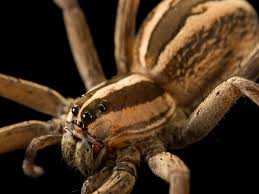If you’ve ever spotted a big, furry spider in your backyard or garden in Florida, you might have come across the Florida Wolf Spider. This intriguing creature is a common sight in the Sunshine State and is known for its impressive hunting skills and unique appearance. In this article, we will dive deep into the world of the Florida Wolf Spider, exploring its behavior, habitat, and why it’s a fascinating part of Florida’s ecosystem.
What is the Florida Wolf Spider?
The Florida Wolf Spider, scientifically known as Hogna cora, is a member of the Lycosidae family. These spiders are called “wolf spiders” because, much like wolves, they are active hunters that chase down their prey. Unlike many spiders that spin webs to catch food, Florida Wolf Spiders prefer to roam the ground in search of insects and other small creatures. They are known for their large size, with some species reaching up to 1.5 inches in body length, and their hairy bodies, which help them blend into their surroundings. Also read Exploring the Florida Wolf Spider: An In-Depth Look at This Fascinating Arachnid
Physical Characteristics of the Florida Wolf Spider
One of the most striking features of the Florida Wolf Spider is its size. These spiders can be quite large compared to other spiders. They have robust, muscular legs and a strong body that allows them to hunt efficiently. Their bodies are covered in fine hairs that can make them look furry. These hairs are not just for show; they help the spider sense vibrations in the environment, which is crucial for detecting prey and predators.
Another interesting characteristic is their eye arrangement. Florida Wolf Spiders have eight eyes, arranged in three rows. The middle row has four larger eyes, which give them excellent vision. This is important for spotting prey from a distance and for navigating their surroundings in low light conditions.
Habitat of the Florida Wolf Spider
The Florida Wolf Spider is commonly found in various habitats across Florida. They thrive in wooded areas, fields, and even in residential gardens. They prefer places where they can hide and hunt effectively. You might find them under rocks, in leaf litter, or in tall grass. These spiders are quite adaptable and can even be found in urban environments, making them a common sight in Florida’s diverse ecosystems.
In their natural habitat, Florida Wolf Spiders build small, burrow-like homes or hide under objects where they can stay safe and hunt. They are most active during the evening and night, when they venture out to search for food. Their ability to adapt to different environments makes them a resilient species.
Behavior and Hunting Techniques
Florida Wolf Spiders are known for their impressive hunting skills. Unlike many spiders that rely on webs to catch their prey, these spiders actively hunt. They use their keen eyesight and swift movements to capture insects and other small creatures. The spider will often stalk its prey, waiting for the perfect moment to pounce.
When a Florida Wolf Spider catches its prey, it uses its strong jaws to inject venom. This venom is used to subdue the prey and begin the process of digestion. The spider then sucks out the juices of its prey, leaving behind the empty shell. This method of feeding allows the spider to get the nutrients it needs to survive and grow.
The Role of the Florida Wolf Spider in the Ecosystem
Florida Wolf Spiders play a crucial role in their ecosystem. As predators, they help control the populations of insects and other small creatures. By keeping these populations in check, they contribute to the balance of the ecosystem. Without predators like the Florida Wolf Spider, certain insect populations could become too large, leading to problems for plants and other animals.
Additionally, the presence of Florida Wolf Spiders can be an indicator of a healthy environment. They are sensitive to changes in their habitat, so their presence can signal that the ecosystem is balanced and functioning well. This makes them an important species to monitor for environmental health.
Are Florida Wolf Spiders Dangerous to Humans?
One common concern about spiders is whether they are dangerous to humans. The Florida Wolf Spider, while large and intimidating to some, is generally not harmful to people. Their venom is designed for subduing insects, not humans. In most cases, a bite from a Florida Wolf Spider will result in minor symptoms, such as redness, itching, or a small bump. These symptoms are similar to those of a mosquito bite and usually resolve on their own without medical treatment.
However, if you are bitten and experience severe symptoms or an allergic reaction, it’s important to seek medical attention. As with any spider bite, it’s better to err on the side of caution and get checked by a healthcare professional if you have concerns.
How to Coexist with Florida Wolf Spiders
If you encounter a Florida Wolf Spider in your home or garden, it’s usually best to leave it alone. These spiders are beneficial and help control pest populations. If you prefer not to have them around, you can take some simple steps to encourage them to move elsewhere. Keeping your yard clean and free of debris can help reduce the places where they might hide. Sealing cracks and gaps around your home can also help prevent spiders from coming indoors.
If you need to remove a spider, it’s best to use a gentle method. You can use a cup and a piece of paper to trap the spider and then release it outside. This way, you can safely remove the spider without harming it.
Fun Facts About Florida Wolf Spiders
Here are a few fun facts about Florida Wolf Spiders that might surprise you:
- They’re Great Climbers: Despite being ground-dwellers, Florida Wolf Spiders can climb surfaces if they need to. This ability helps them escape danger or reach new hunting grounds.
- They Have Good Vision: With their eight eyes, Florida Wolf Spiders have excellent vision. They can see well in low light, which helps them hunt during the night.
- They Can Live a Long Time: In the right conditions, Florida Wolf Spiders can live up to 2 years. This is relatively long compared to many other spider species.
- They Can Regenerate Limbs: If a Florida Wolf Spider loses a leg, it can regenerate a new one. This is a common ability among spiders and helps them survive injuries.
Conclusion
The Florida Wolf Spider is a remarkable part of Florida’s natural world. With its impressive hunting skills, unique appearance, and important role in the ecosystem, this spider deserves our appreciation rather than fear. Understanding more about these fascinating creatures can help us coexist with them and appreciate their place in our environment. Next time you spot a Florida Wolf Spider, remember that it’s not just a spider—it’s a valuable and interesting member of Florida’s wildlife community.





